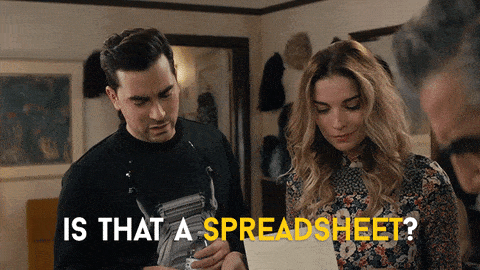- The Vision, Debugged;
- Posts
- Your Spreadsheet's IQ just skyrocketed. Here's why...
Your Spreadsheet's IQ just skyrocketed. Here's why...
PLUS: Think You Can Run a Company? Prove It with This Prompt

Howdy fellas!
Here at The Vision Debugged, Spark and Trouble are buzzing with excitement! They've uncovered a treasure trove of tech marvels today - from spreadsheets that speak AI's language to tools that'll make you feel like a tech mogul. It's time to debug your vision and expand your tech horizons!
Here’s a sneak peek into today’s edition 👀
The AI revolution is coming for your spreadsheets!
Be the Steve Jobs of Your Story: CEO Prompt Inside
3 amazing AI tools that you JUST can’t miss
Time to jump in!😄

Gif by TallBoyz on Giphy
PS: Got thoughts on our content? Share 'em through a quick survey at the end of every edition It helps us see how our product labs, insights & resources are landing, so we can make them even better.

Hot off the Wires 🔥
We're eavesdropping on the smartest minds in research. 🤫 Don't miss out on what they're cooking up! In this section, we dissect some of the juiciest tech research that holds the key to what's next in tech.⚡
Picture this: It's late, you're bleary-eyed, staring at an Excel spreadsheet that seems to stretch into infinity. You know there's valuable information hidden in those cells, but extracting it feels like searching for a needle in a digital haystack. Sound familiar? 📊😵💫
Well, you're not alone! Studies show that while 85% of professionals use spreadsheets for data analysis, less than 30% are actually familiar with their advanced functionalities. It's like owning a Ferrari but only knowing how to use the horn!
But what if your spreadsheet could understand you? What if you could simply ask it questions and get instant answers? That's the promise of tools like Microsoft 365 Copilot in Excel. But isn’t that available only for “paid” users?
Well, agree! But thanks to a groundbreaking paper titled SPREADSHEETLLM: Encoding Spreadsheets for Large Language Models from Microsoft, we're one giant step closer to making this a reality for everyone.
So, what’s new?
Now, you might wonder, "Why do we need a special technique for spreadsheets? Can't AI just read them like any other document?"
Well, spreadsheets pose some unique challenges:
Size matters: Large spreadsheets often exceed token limits, causing information loss.
Structural complexity: The 2D grid structure doesn't align well with the sequential nature of LLMs.
Data sparsity: Empty cells and scattered data can hinder understanding.
Format challenges: LLMs struggle with cell addresses, formats, and data types.
Enter SpreadsheetLLM, wielding two powerful, innovative approaches to tackle these - the “SheetCompressor” encoding framework & “Chain-of-Spreadsheet” reasoning pipeline.

Overall workflow for SpreadsheetLLM (source: SpreadsheetLLM paper)
Under the hood…
SheetCompressor
The core of SpreadsheetLLM is a compression technique called SheetCompressor. Think of it as a magician who can condense a voluminous encyclopedia into a pocket-sized book without losing essential information.
This compression magic is achieved through a combination of techniques:
Structural-Anchor-Based Extraction: This component identifies key structural elements in the spreadsheet, like headers or merged cells through heuristics. It's like finding the load-bearing walls in a house – you know which parts are crucial to keep. This process filters out 75% of content while preserving 97% of the important structural information.

Example of Structural-Anchor-Based Extraction (source: SpreadsheetLLM paper)
Inverted-Index Translation: This two-step compression method can squish spreadsheets by over 14 times! It converts the usual 2D grid into key-value pairs (where the cell values form the keys & the non-empty cell addresses form the values) and then aggregates the ones having the same keys. It's like turning your sprawling spreadsheet into a concise, well-organized filing cabinet.
An inverted index is a data structure used in search engines to facilitate efficient retrieval. It essentially flips the traditional way of organizing data, where each term is associated with a list of documents it appears in, allowing for rapid retrieval of relevant documents based on user queries.

Inverted-Index Translation in action (source: SpreadsheetLLM paper)
Data-Format-Aware Aggregation: This step recognizes different data types automatically and aggregates them for even higher compression – up to 25 times!

Representation of Data-Format-Aware Aggregation (source: SpreadsheetLLM paper)
This overall compression technique led to a staggering 96% cost reduction when using GPT-4!
Chain of Spreadsheet (CoS)
This technique is inspired by the “Chain-of-Thought” (CoT) method of prompting LLMs for better results.
Chain-of-Thought is a prompting approach that allows AI to show its reasoning process step-by-step, thereby consolidating the final answer to provide more accurate result.
In the first step, given the compressed spreadsheet & the task query, the LLM identifies relevant sections of the spreadsheet that may be relevant to the task. In the 2nd step, the LLM focuses fully on those areas to provide accurate answers.
The result? A 22% improvement over using GPT-4 directly on raw spreadsheet data!
The researchers fine-tuned various Language Models for spreadsheet table question-answering tasks using the CoS method, with LLaMA 3 showing the best performance among open-source options. At the same time, GPT-4 led the pack for closed-source models.
Why does this matter?
SpreadsheetLLM's implications are far-reaching. It isn't just about making spreadsheets smarter—it's about democratizing data analysis.
It could transform industries reliant on data-driven decision-making, from finance and healthcare to logistics and supply chain management. By bridging the gap between spreadsheet complexity and user-friendly AI interactions, SpreadsheetLLM has the potential to unlock insights for everyone, not just Excel gurus.
As we eagerly await the wider implementation of this technology (Microsoft Excel Copilot, we're looking at you!), one thing is clear: the future of data analysis is looking a lot more conversational and a lot less intimidating.
So the next time you're knee-deep in pivot tables and VLOOKUPS, remember – the future of spreadsheets is looking brighter (and smarter) than ever!
Key Takeaways
(screenshot this!)
Efficient Encoding Matters: The dramatic improvements in both performance and cost highlight the importance of domain-specific encoding techniques
Context is King: By preserving structural information while reducing unnecessary data, we can give AI models the context they need without overwhelming them
Domain-Specific Solutions: Tailoring AI approaches to specific data formats (like spreadsheets) can unlock new levels of performance and utility
Divide and Conquer: The Chain of Spreadsheet approach shows how breaking complex tasks into smaller, manageable steps can lead to better results

10x Your Workflow with AI 📈
Work smarter, not harder! In this section, you’ll find prompt templates 📜 & bleeding-edge AI tools ⚙️ to free up your time.
Fresh Prompt Alert!🚨
Ever dreamed of running the show without the actual corner office drama? Well, buckle up, boss! This week's Fresh Prompt Alert lets you step into the shoes of a big-shot CEO.
It's like Monopoly, but with less jail time and more strategic decision-making. Perfect for aspiring leaders or anyone who wants to flex their executive muscles without the pesky board meetings.
Ready to lead from the virtual corner office? Give it a shot! 👔💼
I want you to act as a Chief Executive Officer for [company name], which is a [describe the company].
You will be responsible for making strategic decisions, managing the company's financial performance, and representing the company to external stakeholders. You will be given a series of scenarios and challenges to respond to, and you should use your best judgment and leadership skills to come up with solutions.
Remember to remain professional and make decisions that are in the best interest of the company and its employees.
Your first challenge is: “[enter the scenario]“
How will you handle this situation and what steps will you take to mitigate any negative impact on the company?
Spark & Trouble tried this on ChatGPT, to simulate the steps needed to control any of the damages due to the recent Microsoft-CroudStrike outage that wreaked havoc across the world…& the results were pretty impressive!
3 AI Tools You JUST Can't Miss 🤩
✍️ Aithor - Smart AI writing companion for essays, articles & research papers
💻 Archie AI - Turn ideas into software requirements, specifications, and designs with this AI Product Architect
🔮 SticAI Glance - Summarise Reddit post to actionable insights

Spark 'n' Trouble Shenanigans 😜
Did you catch that wild video Elon Musk dropped on X yesterday? It's blowing up the internet!
World leaders and tech bigwigs strutting their stuff in the craziest outfits you've ever seen - all cooked up by AI! It's like a fever dream fashion show meets political satire.
High time for an AI fashion show
— Elon Musk (@elonmusk)
12:49 AM • Jul 22, 2024
In less than a day, this video garnered nearly 43.5 million views! The whole world's talking about it, and everyone's got an opinion.
The video seems to be a satirical take on current world powers and has been described as blending satire with advanced animation3. It also mocks certain events, like Bill Gates’ IT outage, as part of the humour.
But here's the kicker - while everyone's laughing, there's this undercurrent of "Whoa, AI can do THIS now?" It's mind-blowing and a little freaky at the same time, right?
So, what's your take? Love it? Hate it? Totally freaked out? We’re eager to read your replies.

Well, that’s a wrap! Until then, |  |




Reply